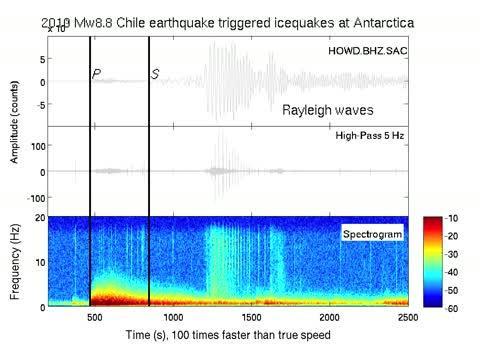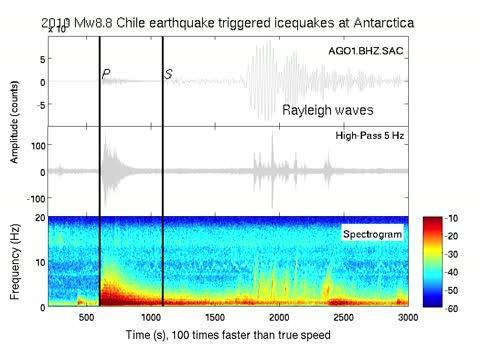Peng says the source locations of the icequakes are difficult to determine because there isn't an extensive seismic network coverage in Antarctica.
"But at least some of the icequakes themselves create surface waves, so they are probably formed very close to the ice surface," he added. "While we cannot be certain, we suspect they simply reflect fracturing of ice in the near surface due to alternating volumetric compressions and expansions as the Rayleigh waves passed through Antarctica's frozen ice."
Antarctica was originally not on the research team's target list. While examining seismic stations in the Southern Hemisphere, Peng "accidently" found the triggered icequakes at a few openly available stations. He and former Georgia Tech postdoctoral student Jake Walter (now a research scientist at the Institute for Geophysics at UT Austin) then reached out to other seismologists (the paper's four co-authors) who were in charge of deploying more broadband seismometers in Antarctica.

High-frequency icequakes are shown at station HOWD in Antarctica during the distant waves of the 2010 magnitude 8.8 Chile earthquake. The triggered icequakes are indicated by the narrow vertical bands in the middle and lower sections of the graphic. They begin when the P wave arrives approximately 8 minutes (480 seconds) after the Chilean quake and continue through the arrival of the Rayleigh waves. The sound is generated by speeding up the HOWD's seismic data 100 times.
(Photo Credit: Georgia Tech)

High-frequency icequakes are shown at station AGO (near the South Pole) in Antarctica during the distant waves of the 2010 magnitude 8.8 Chile earthquake. The triggered icequakes are indicated by the narrow vertical bands in the middle and lower sections of the graphic. They begin when the P wave arrives approximately 10 minutes (600 seconds) after the Chilean quake and continue through the arrival of the Rayleigh waves. The sound is generated by speeding up the AGO's seismic data 100 times.
(Photo Credit: Georgia Tech)

The HOWD Polenet seismic station is located near the northwest corner of the Antarctica's Ellsworth Mountains. It was the station that showed the clearest indication of high-frequency signals following the 2010 Chilean earthquake.
(Photo Credit: Eric Kendrick/Ohio State University)
Source: Georgia Institute of Technology